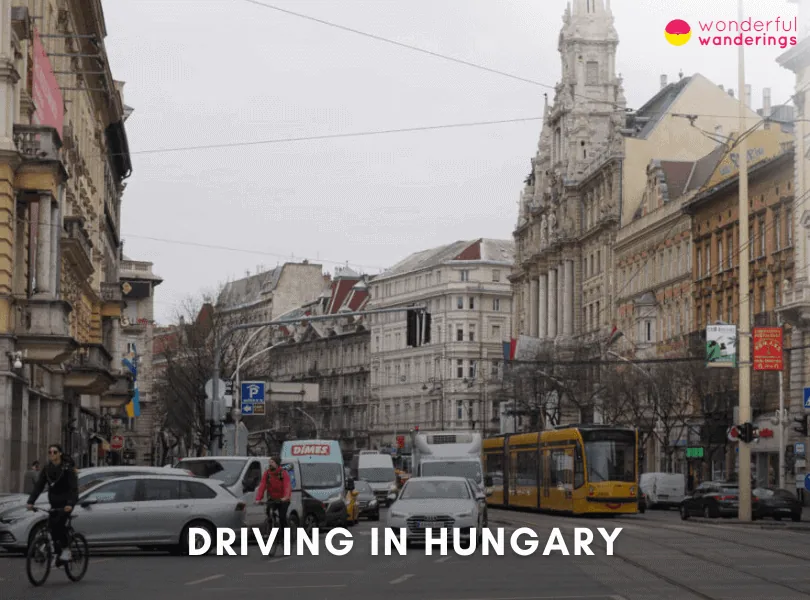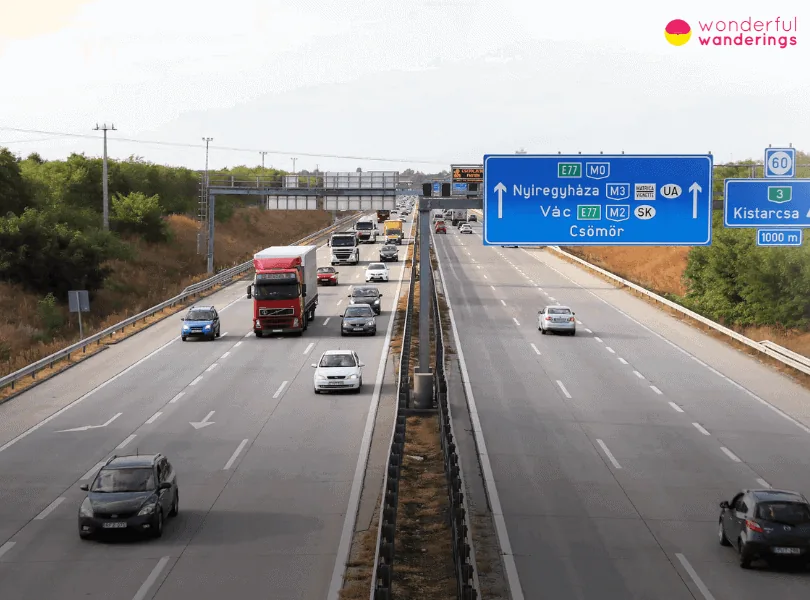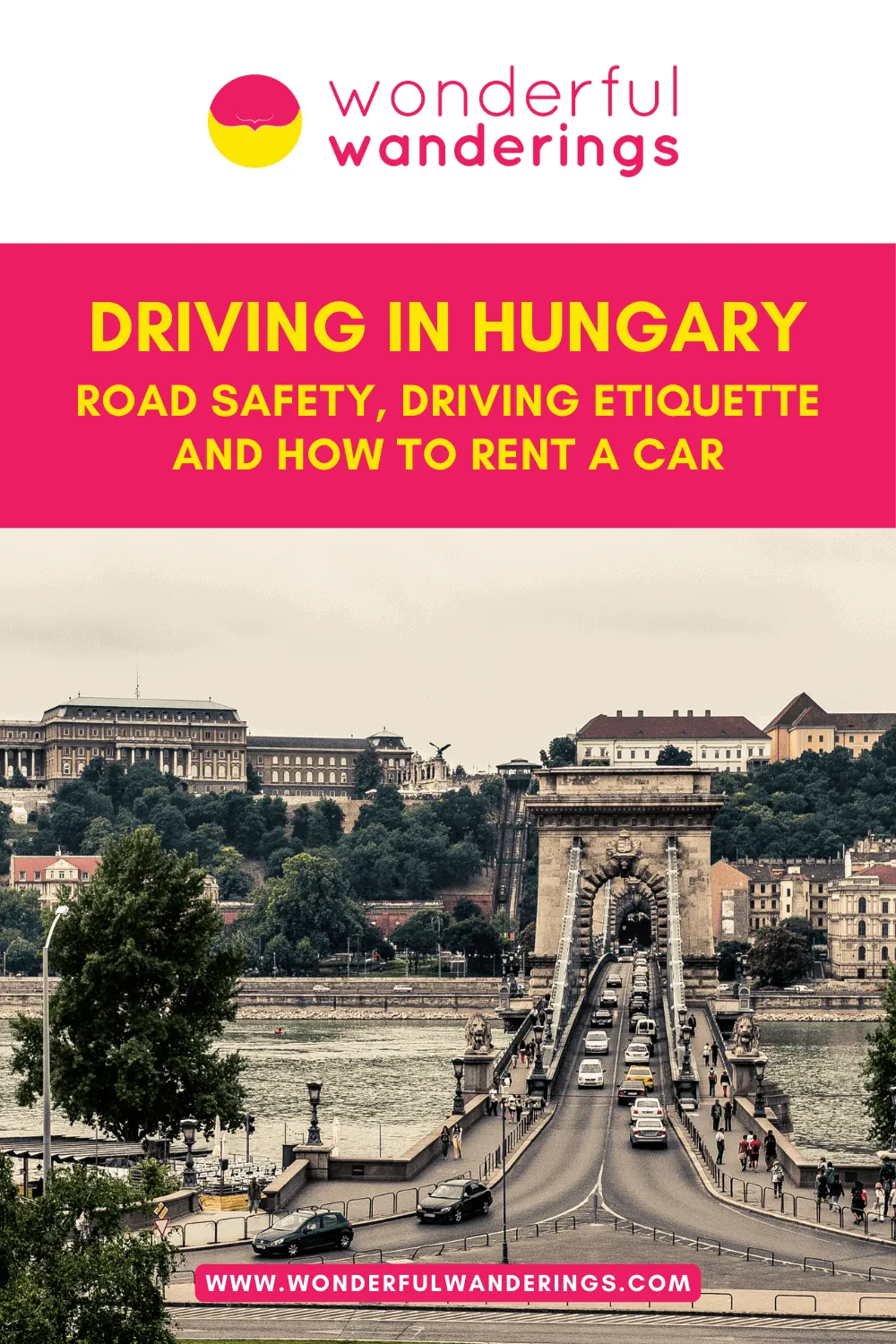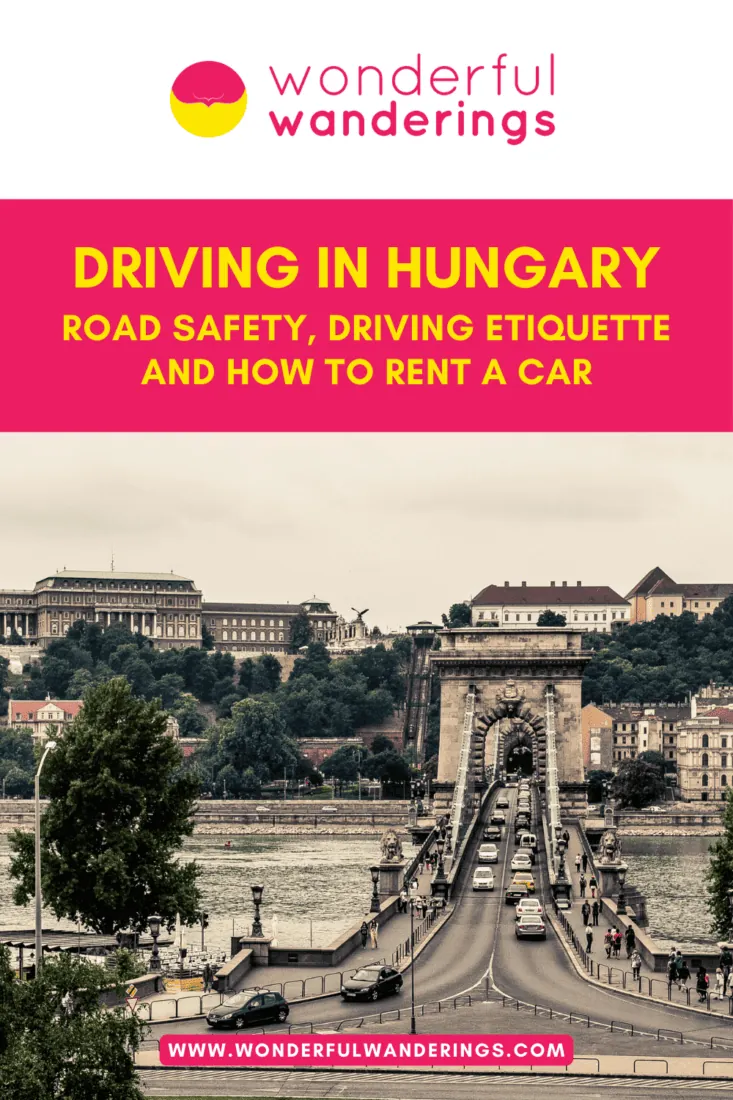Hungary is a landlocked country in Central Europe that offers visitors many cultural and natural attractions. Driving in Hungary is a convenient way to explore the country, but requires some preparation and caution. Road safety is a serious issue in Hungary, as the country has one of the highest rates of road fatalities in Europe. Drivers should always wear seat belts, obey speed limits and traffic signs, and avoid driving under the influence of alcohol or drugs. The legal blood alcohol limit is 0.00%, which means any amount of alcohol is prohibited. Drivers should also be aware of the weather conditions, especially in winter, when roads can be icy or snowy.
Driving etiquette in Hungary is similar to other European countries, but drivers should know some specific rules and customs. Drivers should always use their headlights, even during the day, and flash them to warn other drivers of danger or to signal overtaking. Drivers should also honk their horns to greet or thank other drivers or to express dissatisfaction. Drivers should be courteous and respectful to pedestrians, cyclists, and other road users and avoid aggressive or reckless driving. Renting a car in Hungary is relatively easy and affordable but involves some requirements and fees. Drivers should have a valid driver’s license from their home country, an international driving permit, and a credit card. Drivers should also have a valid passport and visa, if applicable. The average cost of renting a car in Hungary is 20€ ($21.8, £17.4) to 50€ ($54.5, £43.5) per day, but it may vary depending on the type of car, the rental company, and the season. Drivers should also pay attention to the insurance coverage, the fuel policy, and the mileage limit of the rental car.
How is Driving in Hungary?
Driving in Hungary offers visitors a convenient and accessible way to explore the country’s diverse landscapes and vibrant cities. The road network in Hungary is well-developed and maintained, making it easy to navigate from one destination to another. The highways are well-marked, and the signage is clear and easy to understand. As visitors drive through Hungary, they will encounter a variety of beautiful views and scenic spots to stop by. From rolling hills and lush countryside to charming vineyards and historic castles, there is no shortage of sights to enjoy. Some notable stops include the historic town of Eger, known for its medieval fortress and thermal baths, and the Baradla Cave in Aggtelek National Park. Visitors can also take advantage of Hungary’s well-preserved historic towns and cities. Places like Budapest, with its architecture and iconic landmarks like the Chain Bridge and the Parliament Building, offer a unique blend of history and modernity. Driving through these cities allows visitors to explore at their own pace and discover hidden gems.
Is it Easy to Drive in Hungary?
Yes, driving in Hungary is generally easy. The road infrastructure is well-developed, and the traffic is usually well-managed. Visitors will find the roads in good condition, making for a smooth and comfortable driving experience. The signage in Hungary is clear and easy to understand, making it simple for drivers to navigate the country. Road signs are typically in both Hungarian and English, which is helpful for international visitors. The road rules and regulations are similar to those in other European countries, so drivers familiar with driving in Europe will have no trouble adapting to the Hungarian road system.
On which side of the road do people drive in Hungary?
People drive on the right side of the road in Hungary. This is the standard practice in most European countries, and Hungary follows suit. The decision to drive on the right side of the road was influenced by historical and geographical factors. Hungary has been influenced by neighboring countries, such as Austria and Germany, where driving on the right side is the norm. This led to the adoption of right-hand driving in Hungary as well. Hungary’s geographical location in Central Europe further reinforced the decision to drive on the right side, as it facilitated easier connectivity and alignment with neighboring countries. Driving on the right side of the road in Hungary ensures consistency and compatibility with the traffic flow in surrounding countries. It allows for smoother cross-border travel and promotes overall road safety and efficiency. Visitors from countries where driving on the left side is practiced may need to adjust to this change, but with proper awareness and adherence to traffic rules, driving on the right side in Hungary can be easily navigated.
What are Road Safety Tips When Driving in Hungary?
It is crucial to practice safety measures when driving in Hungary to ensure the well-being of the driver and other road users. Adhering to road safety guidelines helps prevent accidents and maintain a smooth and efficient traffic flow. It is essential to adhere to the designated speed limits. In built-up areas, the speed limit is typically 50 kilometers (31 miles) per hour, while on highways, it can range from 90 kilometers to 130 kilometers (56 to 80 miles) per hour. It is important to pay attention to the posted speed limits and adjust the driving speed accordingly to ensure safety and avoid penalties. When overtaking, drivers should exercise caution and follow the necessary regulations. Overtaking is only permitted on the left side of the road and should be done carefully. It is crucial to use turn signals, check for oncoming traffic, and ensure sufficient space to complete the maneuver safely. Being familiar with Hungary’s road signs is essential for safe navigation. Road signs provide important information about directions, warnings, and regulations. Understanding and following these signs is crucial for maintaining road safety. Visitors should familiarize themselves with common road signs in Hungary to ensure a smooth and safe driving experience. It is important to note that Hungary has a strict alcohol limit for driving. The legal blood alcohol concentration limit is 0.0% for drivers who have held a license for less than three years and 0.0% for drivers under the age of 21. For experienced drivers, the limit is 0.05%. It is advisable to avoid consuming alcohol before driving to ensure complete sobriety and prevent any impairment that could compromise road safety.
1. Speed Limits
Speed limits in Hungary are an important aspect of road safety and must be followed by drivers. The speed limits vary depending on the type of road and the location. The speed limit is 50 kilometers (31 miles) per hour in built-up areas like towns and cities. This limit ensures the safety of pedestrians, cyclists, and other vehicles sharing the roads in these densely populated areas. Drivers need to be attentive and drive at an appropriate speed to navigate through the urban environment safely.
On non-built-up roads, the speed limits are typically higher. The limit is 90 kilometers (56 miles) per hour on non-built-up roads, also known as single carriageways. These roads may have one lane in each direction and are meant for faster travel between towns and villages. Adjusting the driving speed according to road conditions and potential hazards is essential. On highways, also known as motorways, the speed limit is between 110 kilometers and 130 kilometers (68 and 80 miles) per hour. These roads are designed for higher-speed travel and allow efficient long-distance journeys nationwide. Drivers must follow the posted speed limits on highways to ensure safe and smooth traffic flow.
2. Overtaking
Overtaking in Hungary follows specific regulations and guidelines to ensure safe and efficient traffic flow. When it comes to overtaking, drivers should exercise caution and adhere to the established rules. In Hungary, overtaking is permitted on the left side of the road. This means that drivers must pass slower vehicles by moving into the lane on the left-hand side. Before overtaking, checking for any oncoming traffic and ensuring enough space and time to complete the maneuver safely is crucial.
Drivers should always use their turn signals when planning to overtake another vehicle. Signaling indicates their intention to change lanes and alerts other drivers on the road. This important safety measure helps prevent accidents and ensures that other drivers know the upcoming maneuvers. It is essential to exercise patience and avoid aggressive or reckless overtaking maneuvers. Drivers should wait for appropriate gaps in traffic, maintain a safe following distance, and choose suitable opportunities to overtake. It is important to consider the speed and behavior of other vehicles on the road and ensure that overtaking is done safely and without disrupting traffic flow.
3. Hungary Road Signs
Hungary road signs are crucial in providing important information to drivers and ensuring safe road navigation. These signs are designed to be clear and easily understandable, using simple symbols and icons to convey their messages. Road signs in Hungary are typically displayed in both Hungarian and English, making it easier for international visitors to comprehend the information. The signs cover various purposes, including directions, warnings, regulations, and information about nearby facilities.
Directional signs guide drivers and indicate the way to various destinations, such as towns, cities, or specific attractions. These signs usually display the names of the locations and provide arrows indicating the correct direction to follow. Warning signs alert drivers to potential hazards or changes in road conditions. They may indicate sharp turns, pedestrian crossings, animal crossings, or other potential dangers. These signs are essential for drivers to anticipate and respond appropriately to potential risks on the road.
Regulatory signs inform drivers of specific rules and regulations they must follow. These signs may indicate speed limits, no entry zones, parking restrictions, or other traffic regulations. Drivers must pay attention to these signs and comply with the rules to ensure road safety and avoid penalties. Information signs provide drivers with useful information about nearby facilities or services. They may indicate the location of rest areas, petrol stations, hospitals, or other amenities that may interest drivers. These signs help ensure drivers can find necessary services along their journey.
4. Alcohol limit for driving in Hungary
Hungary has strict regulations regarding the alcohol limit for driving to ensure road safety. Drivers need to understand and abide by these limits to avoid legal consequences and prioritize their safety and the safety of others on the road. For drivers who have held a license for less than three years, the legal blood alcohol concentration (BAC) limit is set at 0.0%. This means that drivers in this category should not have any alcohol in their system while operating a vehicle. This zero-tolerance policy is aimed at protecting inexperienced drivers and reducing the risk of accidents caused by alcohol impairment.
For drivers who have held a license for more than three years and are over the age of 21, the legal BAC limit is 0.05%. This means that the blood alcohol concentration should not exceed 0.05%. Drivers need to note that even if they are below the legal limit, consuming alcohol can still impair their driving abilities and increase the risk of accidents. It is advisable to exercise caution and avoid consuming alcohol before driving altogether. To enforce these limits, Hungarian authorities conduct regular alcohol tests, especially during traffic stops or in case of suspicion of drunk driving. Penalties for exceeding the legal alcohol limit while driving can include fines, license suspension, and even imprisonment in severe cases. Drivers need to prioritize their safety and the safety of others by refraining from alcohol consumption before driving.
What Should You Need to Know About Petrol Stations in Hungary?
Listed below are the things that visitors should know about petrol stations in Hungary:
- Payment methods: Visitors should be aware that most petrol stations in Hungary accept cash and credit cards, and some also accept fuel cards. Carrying some cash or a credit card for payment is advisable.
- Opening hours: Petrol stations in Hungary have extended operating hours, with many staying open 24 hours a day. This ensures visitors can conveniently refuel their vehicles anytime, even late-night or early-morning hours.
- Services offered: Petrol stations in Hungary often provide additional services beyond fueling, such as car wash facilities, restrooms, convenience stores, and sometimes even food and beverage options. These services can be useful for travelers who need to freshen up or purchase snacks during their journey.
- Self-service vs. full-service: Visitors should note that some petrol stations in Hungary offer self-service fueling, where drivers pump their fuel, while others provide full-service assistance, where attendants fill the customer’s tank. Paying attention to signage indicating whether the station is self-service or full-service is important.
- Fuel types: Petrol stations in Hungary typically offer a range of fuel types, including unleaded petrol (95 and 98 octane), diesel, and often LPG (liquefied petroleum gas). Visitors need to know the type of fuel their vehicle requires and select the appropriate pump accordingly.
What are HotLine Numbers In Case of Emergencies Driving in Hungary?
Listed below are the hotline numbers In case of emergencies driving in Hungary:
- Emergency services: The general emergency hotline number in Hungary is 112. This number can be dialed for urgent assistance in case of accidents, medical emergencies, or other critical situations.
- Police: To report non-emergency incidents or for general assistance, visitors can contact the Hungarian police at 107. This number can be used to report minor accidents, thefts, or other non-life-threatening situations.
- Ambulance: In a medical emergency requiring immediate medical attention, visitors can call for an ambulance by dialing 104. This hotline connects to the emergency medical services in Hungary.
- Fire department: To report fires or request assistance from the fire department, visitors can dial 105. This hotline connects to the Hungarian fire services and should only be used in fire-related emergencies.
- Road assistance: In case of vehicle breakdown or other roadside emergencies, visitors can contact the Hungarian Automobile Club (Magyar Autóklub) at the toll-free number 188. This hotline provides roadside assistance services, including towing, vehicle repairs, and other assistance required while driving in Hungary.
- Tourist Police: Visitors who require assistance or information specifically for tourists can contact the Police at +36 1 438 8080. They can guide on tourist-related matters, including lost belongings, tourist scams, or general inquiries.
- Poison Control: In case of poisoning or accidental ingestion of harmful substances, visitors can contact the National Poison Control Center at +36 80 200 148. They provide immediate assistance and guidance on how to handle poisoning emergencies.
- Gas leaks: If visitors detect a gas leak or suspect a gas-related emergency, it is important to contact the gas emergency hotline at 104. This will connect them to the gas company’s emergency response team, who will provide guidance and assistance.
- Road Traffic Information: For up-to-date information on road conditions, traffic accidents, or road closures, visitors can dial the Hungarian Road Traffic Information Center by dialing 1 777. This hotline provides real-time information to help drivers plan their routes and navigate potential traffic disruptions.
- Foreign Affairs: In case of emergencies related to consular matters or assistance for foreign nationals, visitors can contact the Ministry of Foreign Affairs and Trade at +36 1 458 1000. This hotline is available for inquiries or assistance regarding passports, visas, or other consular issues.
What are the road conditions in Hungary?
The road infrastructure is well-maintained, and the country has an extensive network of highways and secondary roads that connect major cities and towns. The road signage is clear and easy to understand, making it easier for drivers to navigate. Hungary’s traffic rules and regulations are similar to those in other European countries. Drivers must adhere to speed limits, wear seat belts, and follow traffic signals and signs. It is important to note that Hungary follows the right-hand driving system, and overtaking is done on the left. Road users are expected to drive responsibly and avoid aggressive or reckless behavior. The average price of gasoline is 1.5€ ($1.64, £1.31) per liter, while diesel was slightly cheaper. Carrying cash or a credit card for fuel purchases is advisable, as most petrol stations accept electronic payments. Parking in Hungary is available and accessible in towns and cities. Paid parking zones are common, and drivers must display a parking ticket or use a parking meter to pay for parking. Observing parking regulations and restrictions is important to avoid fines or penalties.
What are top places to visit in Hungary with a car?
Listed below are the top places to visit in Hungary with a car:
- Budapest: The capital city of Hungary is a must-visit destination with a rental car. It blends historical sites, nightlife, and architecture. Visitors can explore iconic landmarks such as the Buda Castle, the Hungarian Parliament Building, and the Fisherman’s Bastion.
- Lake Balaton: Through a rental car, travelers can easily reach Lake Balaton, the largest lake in Central Europe. It offers excellent landscapes, towns, and beautiful beaches. Visitors can indulge in water activities, explore historic castles like Tihany Abbey, and enjoy the atmosphere of towns like Siófok and Balatonfüred.
- Eger: Eger is a historical town in northern Hungary known for its beautiful baroque architecture and thermal baths. Visitors can explore the Eger Castle, the Basilica of Eger, and the Eger Thermal Spa with a rental car. The town is also famous for its wine production, with opportunities to visit vineyards and taste the region’s red wines.
- Hortobágy National Park: The Hortobágy National Park is a UNESCO World Heritage site. Travelers can explore the vast grasslands, spot unique wildlife, and visit traditional Hungarian herdsman settlements through a rental car. The park also offers horse shows, bird-watching opportunities, and the chance to experience the traditional Hungarian Puszta lifestyle.
- Pécs: Through a rental car, visitors can easily reach Pécs, a city in southern Hungary. It features a rich history, well-preserved Roman ruins, and a healthy arts scene. Highlights include the Pécs Cathedral, the Zsolnay Cultural Quarter, and the Early Christian Necropolis, a UNESCO World Heritage site.
What is the Proper Driving Etiquette when Driving in Hungary?
There are 4 main proper driving etiquette when driving in Hungary. Firstly, it is crucial to obey all traffic laws and regulations. This includes respecting speed limits, traffic signs, and signals. Visitors should familiarize themselves with Hungarian road rules before driving to ensure compliance and avoid legal repercussions. Adhering to traffic laws promotes order and safety on the roads. Secondly, maintaining a safe following distance is essential. Drivers should keep a reasonable distance from the vehicle in front to allow for adequate braking and reaction time. This helps prevent rear-end collisions and gives everyone on the road a sense of security. It is recommended to follow the general rule of a three-second gap between vehicles. Thirdly, using indicators when changing lanes or making turns is a must. Signaling intentions in advance allows other drivers to anticipate movements and adjust accordingly. This promotes a smooth traffic flow and reduces the risk of accidents caused by sudden lane changes or unexpected turns. Lastly, it is important to yield the right of way appropriately. Drivers should be aware of and yield to vehicles that have the right of way, such as those already on a roundabout or approaching an intersection with priority signs. Respecting right-of-way rules prevents confusion and potential collisions.
How to Park Your Car in Hungary?
Listed below are the instructions to follow when parking a car in Hungary:
- Find a suitable parking spot: Look for designated parking areas such as parking lots, garages, or on-street parking spaces. Pay attention to parking signs and markings indicating any restrictions or time limits.
- Park within the designated space: Ensure that the vehicle is properly parked within the designated parking space, aligning it parallel to the curb if parking on the street. Make sure not to obstruct pedestrian paths or other vehicles.
- Pay for parking, if required: Parking may be subject to payment in some areas. Look for parking meters or ticket machines nearby. Follow the instructions to pay for parking, which may involve inserting coins, using mobile payment apps, or purchasing parking tickets.
- Display parking ticket or permit: If one has paid for parking or has a valid parking permit, make sure to display it visibly. Place the parking ticket on the vehicle’s dashboard or hang the permit from the rearview mirror, ensuring it is easily visible to parking enforcement officers.
- Observe parking regulations: Be aware of any parking regulations specific to the area. This may include restrictions on parking during certain hours, parking in loading zones, or parking in designated disabled parking spots. Adhering to these regulations helps maintain order and avoids fines or penalties.
How to Avoid Getting Traffic Violation Tickets?
Listed below are the different ways to avoid getting traffic violation tickets:
- Observe speed limits: Drivers should stay within the posted speed limits and adjust their speed according to road conditions. Speeding is one of the most common traffic violations and can result in fines or penalties.
- Follow traffic signals and signs: It is important to pay attention to traffic signals, stop signs, yield signs, and other road signs. Obeying these signals and signs helps maintain order and safety on the roads.
- Use turn signals: Drivers should always use their turn signals to indicate their intentions when changing lanes, making turns, or merging into traffic. This allows other drivers to anticipate their movements and reduces the risk of accidents.
- Maintain a safe following distance: Keeping a safe distance from the vehicle in front is recommended to allow for proper braking and reaction time. Tailgating is dangerous and can result in a traffic violation ticket.
- Avoid distractions: Drivers should stay focused on the road and avoid distractions such as using mobile phones, eating, or grooming while driving. Distracted driving is a major cause of accidents and can lead to traffic violation tickets.
- Wear seat belts: All occupants in the vehicle need to be properly buckled up with seat belts. Failing to wear seat belts is unsafe and a traffic violation that can result in fines.
- Yield the right of way: Drivers should understand and yield the right of way to other vehicles when necessary, such as at intersections or when merging into traffic. Failure to yield can lead to accidents and traffic violation tickets.
- Do not drink and drive: It is crucial for drivers to never drive under the influence of alcohol or drugs. Driving while impaired is not only extremely dangerous but also a serious traffic violation that can result in severe penalties, including fines, license suspension, or even imprisonment.
- Park legally: Drivers should always park their vehicles in designated parking areas and follow parking regulations. Illegally parked vehicles can receive parking violation tickets or be subject to towing.
- Regular vehicle maintenance: It is recommended for drivers to keep their vehicles in good working condition by regularly maintaining them. Ensuring that lights, brakes, tires, and other essential components function properly reduces the risk of traffic violations due to faulty equipment.
What are the Tips when Renting a Car in Hungary?
Listed below are the tips when renting a car in Hungary:
- Compare prices and options: Individuals renting a car in Hungary should take the time to compare prices and options from different rental companies. This allows them to find the best deal and choose a vehicle that meets their needs.
- Check for hidden fees: It is important for renters to carefully review the rental agreement and check for any hidden fees or charges. This includes additional insurance, fuel, mileage, or late returns costs. Being aware of these fees in advance can help avoid unexpected expenses.
- Understand insurance coverage: Renters should thoroughly understand the insurance coverage provided by the rental company. They should check if the basic insurance is included and if any additional coverage options are available. It is advisable to consider purchasing extra insurance to ensure protection in case of accidents or damages.
- Familiarize with local driving laws: Before driving in Hungary, one must familiarize oneself with the local driving laws and regulations. This includes knowing the speed limits, parking rules, and specific requirements, such as carrying a reflective vest or having a first aid kit in the vehicle.
- Inspect the car before and after rental: Renters should conduct a comprehensive inspection of the rental car before accepting it. They should carefully check for any existing damages or mechanical issues and report them to the rental company. When returning the car, a thorough inspection should ensure that no new damages are present, preventing any disputes or charges for pre-existing damages.
What Type of Rental Car do you Need on Hungarian Roads?
Listed below are the types of cars that visitors need on Hungarian roads:
- Compact or mid-size cars: Visitors to German roads typically need compact or mid-size cars due to their versatility and ease of maneuverability. These cars are suitable for navigating urban areas and narrow streets, which are common in many German cities and towns.
- Fuel-efficient models: Fuel-efficient rental cars are recommended in Hungary, as fuel prices can be relatively high. A car with good fuel efficiency helps visitors save on fuel costs and allows longer trips without frequent refueling.
- Automatic transmission: Manual transmission cars are common in Hungary, but visitors not accustomed to manual driving may prefer renting a car with an automatic transmission. This provides a more comfortable driving experience, especially in heavy traffic or hilly terrain.
- GPS/navigation system: Having a GPS or navigation system in the rental car benefits visitors exploring Hungary. It helps them navigate efficiently and find their desired destinations, reducing the chances of getting lost or taking wrong turns.
- Adequate storage space: Renting a car with sufficient storage space is important, especially for travelers with luggage or those planning road trips. Having sufficient trunk space or the option for roof racks ensures that belongings can be securely stored during the journey.
What are the Documents Necessary to Rent a Car in Hungary?
Listed below are the necessary documents to rent a car in Hungary:
- Valid driver’s license: Individuals need a valid driver’s license to rent a car in Hungary. This should be an original license issued by their home country or an international driving permit (IDP) if required by their country of residence.
- Passport or identity card: Renters must provide a valid passport or national identity card as a form of identification when renting a car in Hungary. This is necessary for verifying their identity and ensuring compliance with legal requirements.
- Proof of age: Rental companies may require renters to provide proof of age, typically being at least 21 years old or older. Some companies may have specific age restrictions or additional fees for drivers under a certain age.
- Credit card: Renting a car in Hungary generally requires a valid credit card in the renter’s name. This is used for securing the rental and any potential additional charges, such as a security deposit or payment for fuel, tolls, or damages.
- Rental voucher or reservation confirmation: It is advisable to have a rental voucher or reservation confirmation from the rental company. This document proves the rental agreement and contains important details such as the pickup location, dates, and rental terms.
Do Rental Cars have Insurance?
Yes, rental cars have insurance coverage. Car rental companies provide insurance options to protect the rental vehicle and the driver in case of accidents or damages. The specific insurance coverage and terms may vary depending on the rental company and the rental agreement chosen by the customer. The insurance coverage for rental cars often includes a Collision Damage Waiver (CDW) or Loss Damage Waiver (LDW). This type of insurance typically limits the renter’s liability in case of damage to the rental vehicle. It covers the cost of repairs or the vehicle’s value if it is deemed a total loss. Additional insurance options, such as liability insurance or supplemental liability insurance (SLI), may also be available, which covers damages to third parties or their property. Personal Accident Insurance (PAI) may be offered to provide coverage for medical expenses or personal injuries sustained by the driver and passengers. It is important for renters to carefully review the insurance options and terms provided by the rental company before deciding. This allows them to understand the coverage, deductibles, and applicable limitations or exclusions. Some renters may also choose to use their own car insurance or credit card coverage, but it is essential to check with the insurance provider beforehand to determine if rental cars are covered.
Are Roads in Hungary Safe?
Yes, roads in Hungary are safe for travel. The road infrastructure in Hungary is well-maintained, with a network of highways and well-paved roads connecting major cities and towns. The country has implemented strict safety regulations and traffic laws to ensure the safety of drivers and passengers. Hungary has a relatively low rate of road accidents compared to other European countries. The government has invested in road safety measures, including regular road maintenance, clear signage, and efficient traffic management systems. Drivers must remain vigilant and follow all traffic rules while driving in Hungary. This includes obeying speed limits, wearing seat belts, and avoiding distractions while driving. It is also advisable to be cautious of other drivers, especially during peak travel times or in congested areas.
Is a Driving License Required when Driving in Hungary?
Yes, a driving license is required when driving in Hungary. To legally operate a motor vehicle in Hungary, drivers must possess a valid driving license. This can be either an original license issued by their home country or an international driving permit (IDP) if required by their country of residence. The license proves that the driver has met the necessary qualifications and has the knowledge and skills to drive a vehicle safely. Hungarian authorities expect drivers to carry their driving license while driving, as they may be asked to present it during routine traffic checks or in an accident. Visitors must ensure that their driving license is valid and up-to-date before driving in Hungary, as driving without a valid license can result in penalties or legal consequences.
Find below our best travel guides about Hungary.










